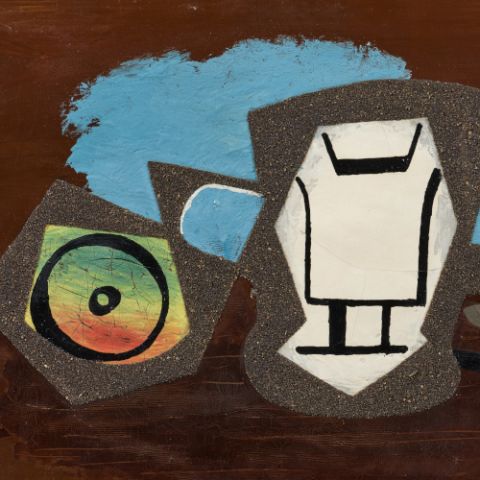
Lot 2 | Sigmar Polke | Untitled
1941 Oels/Lower Silesia - 2010 Cologne
Title: Untitled.
Date: 1972.
Technique: Gouache on paper.
Measurement: 99 x 69,5cm.
Notation: Inscribed verso lower left by a foreign hand: Sigmar Polke 1972 Mischtechnik/Papier
Frame/Pedestal: Framed.
We are grateful to Mister Michael Trier, Cologne, for the kind support.
Provenienze:
- Private collection Rhineland
-Sigmar Polke is one of the most influential German post-war artists and a three-time documenta participant
-Multi-layered work that impressively illustrates Polke's love of experimentation and eclecticism
-Subtly captured erotic constellation of figures in delicate calligraphic contours
Sensual eclecticism
Sigmar Polke's extensive oeuvre encompasses painting, works on paper, photography, film, objects and graphic art. Not bound to any single genre, his artistic creativity is characterised by a joy of experimentation and a free, unconventional approach to media and materials. Polke's professional engagement with art began with an apprenticeship as a glass painter and continued with his studies under Gerhard Hoehme and Karl Otto Götz at the Düsseldorf Art Academy. During this time, he organised his first public exhibition together with Manfred Kuttner, Konrad Lueg and Gerhard Richter, which operated in demonstrative opposition to Socialist Realism with the term ‘Capitalist Realism’. Adopting a subversive position, the fellow students humorously dismantled all classifications of art, as formulated in the programmatic sentence: ‘We are showing for the first time in Germany pictures that can be characterised by terms such as Pop Art, Junk Culture, imperialist or capitalist realism, new representationalism, naturalism, German Pop and some similar terms.’ (ZADIK (ed.): Ganz am Anfang / How it all Began: Richter, Polke, Lueg & Kuttner, Verlag für Moderne Kunst, 2004, typescript, p. 72)
On the basis of this provocative approach, which relishes in undermining the established certainties of the art world, Polke's work embraces an idiosyncratic eclecticism. The artist appropriates images that have been disseminated by the media, for example, and, by removing them from their context, subjects them to a change of meaning. In doing so, he does not distinguish between high and low, or between the serious or entertaining nature of the source of the information. Rather, he levels the visual material from news broadcasts, television shows, advertising, and comics. He unashamedly combines pop, politics and pornography, and melds works of classical visual art with fabric patterns, thus relativising and levelling the messages of different pictorial languages. Multiple reproduction and the resulting banality and arbitrariness are consciously employed means and modes of operation to ironically expose and break the conservative ideals and ideas conveyed in the templates. In doing so, Polke increasingly engages with the myth of art, which he confronts with mischief and prank to reduce the noble values and the role of the artist, especially the cult of genius, to absurdity. His sense of humour and slapstick allows him to present the work of art sometimes as the creation of higher beings, sometimes as magic, as a haunting or an alchemical act.
Distancing blurriness and fleeting figurativeness
In the 1970s, Polke explored photography in depth to investigate the possibilities of pictorial transformation. In 1972, the year he participated in documenta 5, he published the artists' book Bizarre together with Klaus Staeck on the occasion of the federal elections. In a simple plastic cover, it contains a collection of overpainted election posters that Polke had taken in Cologne and Düsseldorf.
The 1972 work on paper ‘Untitled’ is closely related to Polke's photographs, in which blurring is introduced as a pictorially determining and alienating element. At the same time, the work takes up elements of poster art and combines painterly and graphic elements in three interpenetrating layers. The two-coloured background consists of a continuous pattern of red and black diagonal stripes of irregular width. They are covered by milky, matt streaks, from which the delicate contours of the erotic constellation of figures emerge schematically. This chalky haze, spread over the surface like a gestural all-over, is reminiscent of the smears left by a sponge on a blackboard. The effect achieved is one of both transparency and opacity, while at the same time emphasising the fleeting nature of the calligraphic-looking drawing, which is executed with just a few strokes and whose outlined figurativeness refers to the language of comics. The interweaving of different stylistic quotations highlights Polke's multimedia approach in favour of the ambiguity of the image.
Bettina Haiss
Print this lot | Recommend lot |
Conditions of this Lot
32% buyer’s premium on the hammer price
Estimated shipping costs for this lot:
Arrangement after the auction.
Sigmar Polke Germany Capitalistic Realism New Realism Post-War Art Post War 1970s Framed Nude Works on paper Mixed media Figure / Figures



